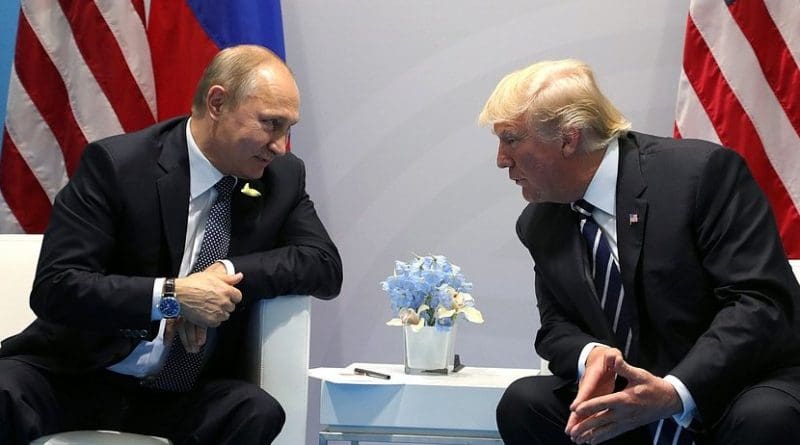When Trump And Putin Meet In Helsinki – Analysis
By Observer Research Foundation
The Helsinki summit presents an opportunity for the US and Russia to resume a dialogue even if to disagree on matters.
By Himani Pant
As the two most powerful presidents of the world, Donald Trump of the US and Vladimir Putin of Russia, prepare to meet in Helsinki next week, the trajectory of US-Russia relations is back in focus once again. Despite low expectations, the upcoming summit on 16 July is important for its role in resuming a working relationship between the US and Russia at a time when their extent of communication has reduced to “alarming” levels.
Notwithstanding the pro-Russian stance of Donald Trump’s presidential campaign, the reset with Russia has remained virtually absent on ground. Driven by his own erratic impulses and a lack of support from the administration, Trump has hardly followed a coherent policy towards Russia. Contrary to expectations, several negative measures, including the supply of lethal weapons to Ukraine, expulsion of Russian diplomats and imposition of stricter sanctions on Russia, have taken place since he assumed office last year. The two countries even came close to a confrontation earlier this year when the West launched airstrikes in Syria.
Though there are various areas of concern like Afghanistan, China, North Korea and the Arctic, the agenda of the Helsinki summit is expected to centre on the most contentious issues, including Ukraine, Syria, Iran, cybersecurity and arms control.
Ukraine, sanctions and cybersecurity
The scope of discussion over Crimea is bleak given Russia’s refusal to compromise on the matter. Kremlin’s spokesperson, Dmitri Peshkov, recently stated that the Russian President is open to looking for compromises with Trump on all other issues but Crimea. This opens a window of opportunity to discuss the situation in Eastern Ukraine. While the prospect of a concrete agreement remains unlikely, a resumption of talks on the matter would give a new impetus to the Minsk process. This would include talks on the possibility of deploying United Nations peacekeepers in East Ukraine.
The issue of sanctions would also be on the agenda though no breakthrough is anticipated. Since the overall sanctions are in response to diverse issues, including Russia’s alleged interference in the 2016 presidential election as well as its action in Crimea, addressing mutual concerns at the summit would be an ideal option.
Given Trump is bound by Countering America’s Adversaries Through Sanctions Act (CAATSA), the maximum he could venture is to provide clarity on the scope of sanctions. There is a squeeze on foreign investment in Russia underway, especially since the latest round of sanctions in April. If Trump is able to provide some clarity on the scope of sanctions, it may help in unfreezing investment from investors who are wary of secondary sanctions.
Though there are differences over Russia’s alleged interference in the US election, the summit could take the conversation forward on cybersecurity. For instance, both could initiate talks on some sort of a cyber-agreement, committing towards non-interference in future.
Syrian conflict and Iran
On Syria, Russia’s long-standing policy has been that of supporting the Syrian President, Bashar Assad, contrary to the US preoccupation in ousting him. However, Assad is no longer a “strategic issue” like it used to be. Rather, it is the growing Iranian influence in Syria which is a cause of concern for the US as well as Israel. Growing Iranian influence is also a matter of concern for Russia, as it would like to maintain the upper hand in the region. While complete rollback of Iranian military is a far-fetched proposition, scaling back the forces, especially along the Israeli border, appears plausible. The goal, however, should be on the long-term solution to the Syrian conflict by bringing focus on the Geneva process.
Arms control
Finally, a discussion on arms control is another crucial area but its scope depends on the willingness from both the US and Russia as they continue to invest in their military. Both have also repeatedly accused one another of violating the 1987 Intermediate Nuclear Forces (INF) Treaty.
Speaking in support of renewing the US nuclear capability last year, Trump had stated, “if countries are going to have nukes, we’re going to be at the top of the pack.” Earlier this year, Putin too unveiled an array of new nuclear weapons, and cautioned Western governments to “take account of a new reality.”
The New Strategic Arms Reduction Treaty (START) office expires in 2021. The treaty essentially aims at limiting the size of the American and Russian nuclear arsenals and allows for inspections. The Helsinki summit could deliberate on the extension of New START for another five years once a consensus is reached.
Notwithstanding the scepticism surrounding the Helsinki summit, it presents an opportunity for the US and Russia to resume a dialogue (even if to disagree on matters). Perhaps, its biggest advantage is the low expectation of significant outcomes due to which even minimal headway would be seen as a success.
The main challenge is whether the two are able to continue with the dialogue. Apart from discussing various issues, it would serve both sides well to agree on continuing regular bilateral meetings. A consistency in this regard also bodes well for the stability of the world in general.

